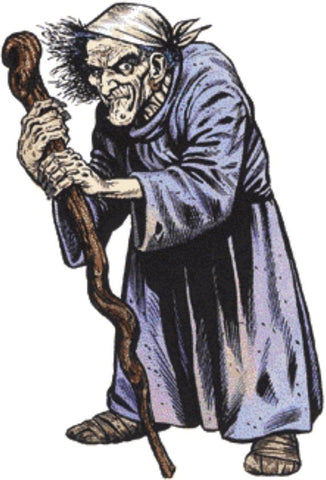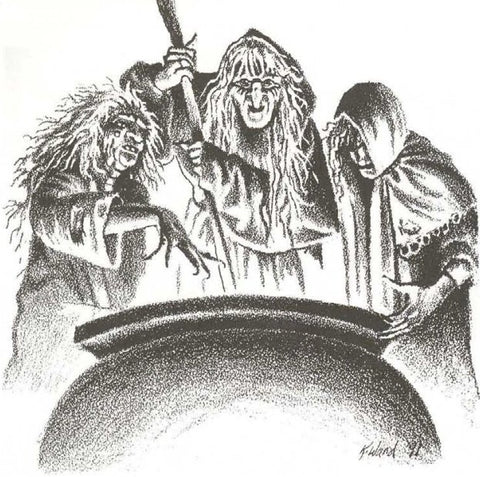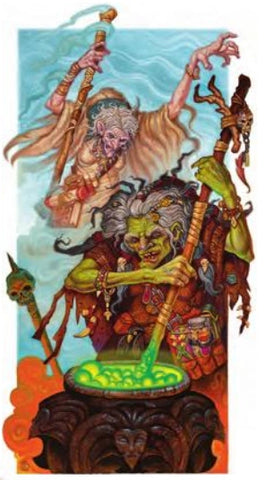Dungeons and Dragons has no dearth of powerful and vicious villains, various factions who wish to promote both themselves and evil in the same breath, casting curses and haunting dungeons. One such type of villain is the hag – a malicious fey creature who makes and manipulates unfair deals, eats children, and curses anyone who gets in the way of her vile intentions. Hags are a frequent sight in campaigns that include fairies and other uncivilized dangers. They’ve even had something of a boost in acknowledgement recently, being featured as an early villain in the video game Baldur’s Gate 3.
Over the years, hags have been included in every edition of Dungeons and Dragons after the 2nd, their lore growing and evolving into the horrifying non-mothers that we know them to be today.
What is a Hag?

A hag is a fey creature that takes on the appearance of a hideous, elderly woman who seems to take great delight in appearing as gross and unnerving as possible. They generally wear worn-out rags, and adorn themselves with bones, viscera, and dirt that they take from their victims. They love selfishness, ugliness, and evil in the instinctive way that most fey love beauty and mortals love goodness, and view any suffering that they can add to the world as a net boon to it. As such, they rarely have a good relationship with other creatures, even other hags.
There are many, many different varieties of hag: Annis, Bheur, Bog, Green, Hannya, Night, Sea, Shrieking, Silat, Winter, Dusk, Dune, Death, Pact, Mist, Dream, Howling, Filth, River, Stygian, Briar and Hagspawn. Each has their own appearance and behavior. Each of these types works alone, but they have been known to operate in groups called ‘covens,’ in which there is rarely more than one subtype present. When they form, a coven can be anywhere from 3 to 13 members, although the lowest number is the most effective.

Their disinclination toward their fellows means that their groups are prone to disagreement, which other members must manage. Having a group of 3 also pleases the symbolic nature of the number ‘3’, which has magical connotations, not only in D&D fey magic, but in the real-world mythologies that hags are taken from.
Most hags spend their days either hunting down victims, either to cause misery or to eat, or convincing people to bring those victims to them. This is possible due to their reputation as problem-solvers and wish-granters, utilizing dark magic and unknown secrets. Whether they are disguised or not, mortals often find themselves desperate enough to seek the power of a hag, thinking that they can endure or outsmart the creatures. While some can, most do not – to a hag, the victim’s suffering is the point of allowing any bargain at all, unless the individual has something even better to offer them.
A Brief History of the Hag in D&D

The first hag to appear is the Night Hag, from the 1977 Monster Manual. They don’t look much like hags as we currently know them, though. For one, they hunt souls rather than flesh and favors, and are heavily associated with Hades and the Lower Planes, rather than the Feywild. While this lore remains true for Night Hags, they’re still markedly different from most subspecies.
Annis, Sea Hags, and Green Hags were added soon after, grouped together under the general title of ‘hag,’ and given more traditional ‘hag’ traits. For one, they aren’t nearly so associated with demons or devils, although they remain frightening and flesh-hungry.
Changes to Hags
Later books, even within 2nd edition, added more lore for the already-established subtypes, and added several more, including the Hannya, Silat, and Bheur.
3rd edition updated the hags for the new rules, but kept them mostly the same in terms of strength and abilities. Later publications, like in 2nd edition, added in more subtypes, this time Bog, Shrieking, Hagspawn, Dusk, and Winter hags.
3rd edition also added to the lore of the Green and Annis Hags through articles in Dragon Magazine. These articles established where the first hags came from. Green hags, seemingly, come from a single druid cursed by the forest itself for sleeping with a cruel hunter. And Annis hags are the transformed followers of a former moon goddess who has sworn herself to vengeance against the gods.

4th edition added yet more hags: Death, Howling, Pact, Briar, Dream, Mist, Filth, Stygian, and River. They don’t have much lore, but are just as powerful as you would expect – more, even, given that 4e is generally somewhat higher-powered than other editions.
Finally, 5e pares down its hags. Their number of subtypes were reduced to a bare 6: Night, Annis, Green, Bheur, Sea, and Dusk. These hags are also much less powerful – they vary wildly in challenge rating, and no longer have their ogre and giant protectors. They also don’t seem to be interested in eating human flesh anymore, for some reason, and even enjoy keeping in contact with each other.
Using Hags in Your Campaigns

Hags are a classic villain, and not just for smaller questlines like in Baldur’s Gate 3. In fact, a coven of hags makes up the overall villain of Wild Beyond the Witchlight, having united their powers to freeze an archfey in time and take over her domain. They’re also pretty easy to introduce.
You can easily bring in a hag, or a coven thereof, by sending your players on a simple quest that spirals out of control. They might want to help a hag’s victim, killing the hag to break her curses, but that’s easier said than done. And even if they do succeed, hag covens don’t keep empty spaces for long – and the ‘try-outs’ for new members are some of the most devastating events that an area can undergo.
Or perhaps one of your players has some big, nigh-impossible goal that they want to achieve. A hag could grant their wish (reviving a loved one, granting them power, or any other such noble goal), but the price would probably be more than they wanted to pay. If they realize their mistake in time, they could fight against the hag, with all the complications listed in the previous paragraph. And if they don’t realize in time, falling for the hag’s fey glamour, well, then they’ll have to find a way to deal with those consequences.
You could even subvert the usual trope – hags are powerful, knowledgeable, and excellent alchemists. They make for fun and interesting shopkeepers, and are likely to have a lot of items that your players will want – if they’re willing to make a bargain for them!
Have you ever used a hag in your campaigns? Were they an NPC, or an enemy? Did your players like them, or like fighting them? Let us know in the comments below!





